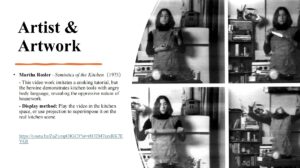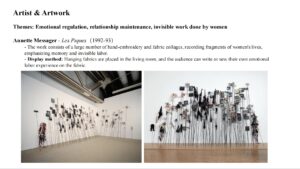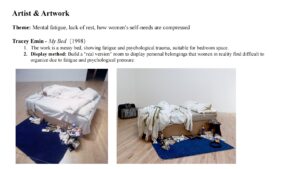About the initial selection of artists and works for the exhibition
In the process of curating the exhibition, I found that the selection of artists was much more complicated than I had initially imagined. At first, when looking for suitable artists, I had almost no idea where to start, and relied more on search engines to conduct extensive searches with the keyword “feminist artists”. This slightly clumsy method reflects my unfamiliarity with resources and methods in the early stages of curating, and also made me realize that curating is not a simple “selection” process, but requires in-depth thinking based on clear thematic awareness and critical screening.
After the initial screening, I finally identified several feminist works of great significance. In the kitchen area, I chose Martha Rosler’s “Semiotics of the Kitchen” and Mierle Laderman Ukeles’ “Maintenance Art Manifesto”. These two works deeply criticize the role of women in the family space from the perspective of the language system and daily maintenance labor, which fits my positioning of the kitchen as a symbolic space for family labor.

In the living room area, I chose Annette Messager’s “Les Piques”. By mixing materials and texts, she showed the complex and fragile relationship between the female body and everyday objects, giving the living room, a more open and communicative space, a sense of privacy and potential violence.

In the bedroom area, I selected two paintings by Caroline Walker, “Guest Change” and “Bedding, Room”, and Tracey Emin’s famous installation “My Bed”. Walker delicately captured the invisible efforts of female workers in seemingly private spaces, while Emin broke the idealized imagination of “family” and “bedroom” through a very personal arrangement, showing the real state of emotions, chaos, and body.

However, in the process of determining these works, I also felt obvious contradictions and shortcomings. In fact, these works do not fully fit my theme of “invisible labor of women in the family”. Some works are more inclined to private emotional expression rather than explicitly discussing issues of labor and the system. I have some concerns about this deviation, but I also realize that a perfect fit is almost impossible to achieve in the early stages of curation. The complexity and openness of the artworks themselves also mean that they can be reinterpreted and activated through curatorial texts and spatial narratives.
Therefore, at this stage, I choose to temporarily retain these works and regard them as part of the curatorial exploration. I hope to continue to critically examine the relationship between the works and themes in the next process, constantly adjust and deepen, rather than being framed by the initial selection. Curating is not a process of finding a perfect match, but a dynamic practice of constant negotiation, revision and reimagining.

